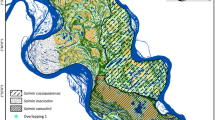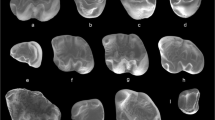Abstract
Eleven taxa of primates are found in the floodplains of the western portion of the central Brazilian Amazon, protected in part by the Mamirauá Sustainable Development Reserve. The taxonomy of the squirrel monkeys, the number of taxa, and their geographic distributions are still poorly understood. Here we investigate differentiation among the taxa of this genus in Mamirauá, examining their morphology and geographic distribution. We registered 333 points of occurrence of squirrel monkeys and examined 117 specimens deposited in scientific collections. The results of the morphological analyses were generally in good agreement with field observations. Together they indicate the existence of three taxa: Saimiri vanzolinii, Saimiri sciureus macrodon, and S. s. cassiquiarensis. The restricted range of Saimiri vanzolinii in the southeastern portion of the reserve covers an area of 870 km2, and it is among the smallest of the distribution areas for any Neotropical primate species. Saimiri sciureus cassiquiarensis has a disjunct distribution, crossing the Japurá River to the right bank into the reserve in two places, and S. s. macrodon is the squirrel monkey ranging widely in the northwest of Mamirauá. There are three areas of parapatry: one between Saimiri vanzolinii and Saimiri sciureus macrodon and two between S. vanzolinii and S. s. cassiquiarensis. We recommend that anthropogenic changes in the region be monitored, and conservation measures be taken to protect these primates, especially considering the endemism and very restricted range of Saimiri vanzolinii and its consequent vulnerability to extinction.


Similar content being viewed by others
References
Aquino, R., & Encarnación, F. (1994). Primates of Peru/Los Primates del Perú. Primate Report, 40, 1–127.
Ayres, J. M. (1985a). Monkeys in the flooded forest of Brazilian Amazonia. Primate Eye, 26, 10.
Ayres, J. M. (1985b). On a new species of squirrel monkey, genus Saimiri, from Brazilian Amazonia (Primates, Cebidae). Papéis Avulsos de Zoologia, 36(14), 147–164.
Ayres, J. M. (1985c). The white uakaris: Seed predators of the Amazonian flooded forest. Twycross Zoo News, 1(3), 6–8.
Ayres, J. M. (1986). The conservation status of the white uakari. Primate Conservation, 7, 200–206.
Ayres, J. M. (1993). As matas de várzea do Mamirauá – Médio Rio Solimões. Série Estudos de Mamirauá. Vol. I. Rio de Janeiro: Sociedade Civil Mamirauá e CNPq/PTU.
Ayres, J. M., & Clutton-Brock, T. H. (1992). River boundaries and species range size in Amazonian primates. The American Naturalist, 140(3), 531–537.
Ayres, J. M., & Johns, A. D. (1987). Conservation of white-uakaris in Amazon várzea. Oryx, 21(2), 74–79.
Baldwin, J. D. (1985). The behavior of squirrel monkeys (Saimiri) in natural environments. In L. A. Rosenblum & C. L. Coe (Eds.), Handbook of squirrel monkey research (pp. 35–53). New York: Plenum Press.
Bender, M. A., & Metler, L. E. (1958). Chromosome studies of primates. Science, 128, 186–190.
Boinski, S., & Cropp, S. J. (1999). Disparate data sets resolve squirrel monkey (Saimiri) taxonomy: Implications for behavioral, ecology and biomedical usage. International Journal of Primatology, 20(2), 237–256.
Chiou, K. L., Pozzia, L., Lynch Alfaro, J. W., & Di Fiore, A. (2011). Pleistocene diversification of living squirrel monkeys (Saimiri spp.) inferred from complete mitochondrial genome sequences. Molecular Phylogenetics and Evolution, 59, 736–745.
Costello, R. K., Dickinson, C., Rosenberger, A. L., Boinski, S., & Szalay, F. S. (1993). Squirrel monkey (genus Saimiri) taxonomy. A multidisciplinary study of the biology of species. In W. Kimbel & L. Martin (Eds.), Species, species concepts and primate evolution (pp. 177–210). New York: Plenum Press.
Defler, T. R. (2004). Primates of Colombia. Santa Fe de Bogotá, Colombia: Conservación Internacional – Colombia.
Egozcue, J., Perkins, E. M., Hagemenas, F., & Ford, D. M. (1969). The chromosomes of some platyrrhini (Callicebus, Ateles and Saimiri). Folia Primatologica, 11, 17–27.
Groves, C. P. (2005). Order Primates. In D. E. Wilson & D. M. Reeder (Eds.), Mammal species of the world: A taxonomic and geographic reference (3rd ed., pp. 111–184). Baltimore: The Johns Hopkins University Press.
Hershkovitz, P. (1984). Taxonomy of the squirrel monkey genus Saimiri (Cebidae, Platyrrhini): A preliminary report with description of a hitherto unnamed form. American Journal of Primatology, 7, 155–210.
Hershkovitz, P. (1987). Uacaries, new world monkeys of the genus Cacajao (Cebidae, Platyrrhini): A preliminary taxonomic review with the description of a new subspecies. American Journal of Primatology, 12, 1–53.
Hill, W. C. O. (1960). Primates comparative anatomy and taxonomy. Vol. IV: Cebidae, Part A. Edinburgh: Edinburgh University Press.
IUCN. (2013). The IUCN Red List of Threatened Species. http://www.iucnredlist.org (Accessed 17 July 2013).
Jones, T. C., Thorington, R. W., Hu, M. M., Adams, E., & Cooper, R. W. (1973). Karyotypes of squirrel monkeys (Saimiri sciureus) from different geographic regions. American Journal of Physical Anthropology, 38, 269–278.
Junk, W. J. (1989). The flood pulse and tree distribution in central Amazonian floodplains. In L. B. Holm-Nielsen, I. C. Nielsen, & H. Balslev (Eds.), Tropical forests: Botanical dynamics, speciation and diversity (pp. 47–64). London: Academic Press.
Lamote, S. (1990). Fluvial dynamics and succession in the lower Uacaly River basin, Peruvian Amazonia. Forest Ecology and Management, 150, 147–174.
Lavergne, A., Ruiz-García, M., Catzeflis, F., Lacote, S., Contamin, H., Mercereau-Puijalon, O., Lacoste, V., & Thoisy, B. (2010). Phylogeny and phylogeography of squirrel monkey (genus Saimiri) based on cytochrome b genetic analysis. American Journal of Primatology, 72, 242–253.
Lönnberg, E. (1940). Notes on some members of the genus Saimiri. Arkiv für Zoologie, 32A(21), 1–18.
Machado, A. B. M., Martins, C. S., & Drummond, G. M. (2005). Lista da fauna brasileira ameaçada de extinção: incluindo as espécies quase ameaçadas e deficientes em dados. Belo Horizonte: Fundação Biodiversitas. 158 p.
MacLean, P. D. (1964). Mirror display in the squirrel monkey, Saimiri sciureus. Science, 146, 950–952.
Mittermeier, R. A., & Van Roosmalen, M. G. M. (1981). Preliminary observations of habitat utilization and diet in eight Surinam monkeys. Folia Primatologica, 36, 1–39.
Muniz, I. (2005). Desenvolvimento do dimorfismo sexual nos macacos-de-cheiro (Saimiri Voigt, 1831). MSc thesis. Universidade Federal do Pará and Museu Paraense Emílio Goeldi, Belém, Brasil.
Paim, F. P., & Queiroz, H. L. (2009). Diferenças nos parâmetros acústicos das vocalizações de alarme das espécies de Saimiri Voigt, 1831 (Primates, Cebidae) na floresta de várzea – Reserva Mamirauá. Uakari, 5(1), 49–60.
Peixoto, J. M. A. (2007). Monitoramento da dinâmica da geomorfologia fluvial da Reserva de Desenvolvimento Sustentável Mamirauá, por meio de técnicas de sensoriamento remoto. MSc thesis, Universidade Federal do Amazonas and Instituto Nacional de Pesquisas da Amazônia, Manaus, Brasil.
Pires, J. M. (1973). Tipos de vegetação da Amazônia. Publicações Avulsas do Museu Paraense Emílio Goeldi, 20, 179–202.
Queiroz, H. L. (1995). Preguiças e Guaribas: Os mamíferos folívoros arborícolas do Mamirauá. Rio de Janeiro: MCT-CNPq and Sociedade Civil Mamirauá.
Ramalho, E. E., Macedo, J., Vieira, T. M., Valsecchi, J., Calvimontes, J., Marmontel, M., & Queiroz, H. L. (2009). Ciclo hidrológico nos ambientes de várzea da Reserva de Desenvolvimento Sustentável Mamirauá – médio Rio Solimões, período de 1990 a 2008. Uakari, 5(1), 61–87.
Rylands, A. B., & Mittermeier, R. A. (2009). The diversity of the New World primates (Platyrrhini): An annotated taxonomy. In P. A. Garber, A. Estrada, J. C. Bicca-Marques, E. W. Heymann, & K. B. Strier (Eds.), South American Primates: Comparative perspectives in the study of behavior, ecology, and conservation (pp. 23–54). New York: Springer Science+Business Media.
Rylands, A. B., Mittermeier, R. A., & Silva Júnior, J. S. (2012). Neotropical primates: Taxonomy and recently described species and subspecies. International Zoo Yearbook, 46, 1–14.
Rylands, A. B., Schneider, H., Langguth, A., Mittermeier, R. A., Groves, C. P., & Rodríguez-Luna, E. (2000). An assessment of the diversity of New World primates. Neotropical Primates, 8, 61–93.
Schwindt, D. M., & Ayres, J. M. (2004). Parapatric groups of black and common squirrel monkeys (Saimiri vanzolinii and Saimiri sciureus) in the central Amazon. American Journal of Physical Anthropology, 38(Supplement), 177.
Silva, J. S., Jr., & Queiroz, H. L. (2008). Saimiri vanzolinii (Primates, Cebidae). In A. B. M. Machado, G. M. Drummond, & A. P. Paglia (Eds.), Livro vermelho da fauna brasileira ameaçada de extinção, Vol. II (pp. 758–760). Belo Horizonte: Fundação Biodiversitas.
Sociedade Civil Mamirauá. (1996). Mamirauá: Plano de Manejo. Brasília and Manaus: CNPq-MCT and IPAAM.
Srivastava, P. K., Srivastava, A. K., & Lucas, F. V. (1969). Somatic chromosomes of squirrel monkey (Saimiri sciureus). Primates, 10, 171–180.
Terborgh, J. (1983). Five New World primates: A study in comparative ecology. Princeton, NJ: Princeton University Press.
Thorington, R. W. (1985). The taxonomy and distribution of squirrel monkey (Saimiri). In L. A. Rosenblum & C. Coe (Eds.), Handbook of squirrel monkey research (pp. 1–33). New York: Plenum Press.
Tirira, D. (2007). Guía de Campo de los Mamíferos del Ecuador. Publicación Especial sobre los Mamíferos del Ecuador, Vol. 6. Quito, Ecuador: Ediciones Murciélago Blanco.
Valsecchi, J. (2005). Diversidade de mamíferos e uso da fauna nas Reservas de Desenvolvimento Sustentável Mamirauá e Amaná – Amazonas – Brasil. MSc thesis, Universidade Federal do Pará and Museu Paraense Emílio Goeldi, Belém, Brasil.
Vanzolini, P. E. (1970). Zoologia sistemática, geografia e a origem das espécies (Série Teses e Monografias). São Paulo: Institudo de Geografia da Universidade de São Paulo.
Vieira, T., Oliveira, M., Queiroz, H. L., & Valsecchi, J. (2008). Novas informações sobre a distribuição de Cacajao calvus na Reserva de Desenvolvimento Sustentável Mamirauá. Uakari, 4(2), 41–51.
Acknowledgments
This research was funded by the Instituto de Desenvolvimento Sustentável Mamirauá (IDSM-OS/MCTI). The Instituto Brasileiro do Meio Ambiente e dos Recursos Naturais Renováveis (IBAMA) conceded licenses for specimen collection in ASDR and MSDR (CGFAU/LIC 086/2004 and SISBIO 14080-1/2008). We thank the Museu Paraense Emílio Goeldi (MPEG), Museu de Zoologia of the University of São Paulo (MZUSP), and Museu Nacional of the Federal University of Rio de Janeiro (UFRJ-MN) for permitting access to their scientific collections. We are grateful to IDSM and the Grupo de Pesquisa em Ecologia de Vertebrados Terrestres for logistical support, and to the field assistants and communities of the Mamirauá and Amanã reserves that helped in carrying out our research. Izaura Muniz helped in taxidermy and Nayara de Alcântara Cardoso helped in the elaboration of the maps. We thank Angela Steward for translating the original text from Portuguese to English, Rafael Magalhães Rabelo for final revision, and Dr. Jessica Lynch Alfaro for suggestions on this manuscript. We also acknowledge two anonymous reviewers for constructive comments on the manuscript.
Author information
Authors and Affiliations
Corresponding author
Appendix
Appendix
Rights and permissions
About this article
Cite this article
Paim, F.P., de Sousa e Silva Júnior, J., Valsecchi, J. et al. Diversity, Geographic Distribution and Conservation of Squirrel Monkeys, Saimiri (Primates, Cebidae), in the Floodplain Forests of Central Amazon. Int J Primatol 34, 1055–1076 (2013). https://doi.org/10.1007/s10764-013-9714-8
Received:
Accepted:
Published:
Issue Date:
DOI: https://doi.org/10.1007/s10764-013-9714-8




